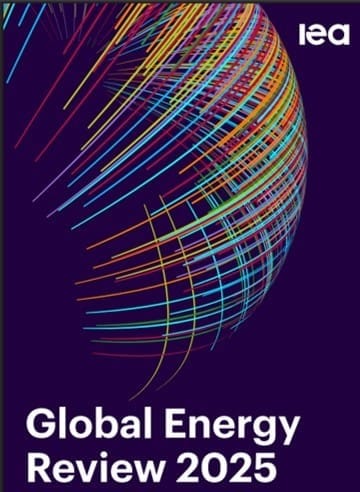Global Energy in Flux
The Global Energy Review 2025 shows clean energy growth accelerating, but rising demand is driving fossil fuel use and emissions to new highs. Without faster innovation and stronger policy, the energy transition risks falling short of climate goals.

The International Energy Agency just released its Global Energy Review 2025, a rigorous and unflinching analysis of the world’s energy system in transition. At a time marked by geopolitical tension, economic recovery, and intensifying climate disruption, the report offers a panoramic, data-rich account of what transpired across the global energy landscape in 2024. Its message is layered but clear: while low-emission technologies are scaling faster than ever, fossil fuel consumption continues to grow in absolute terms. The dual reality presents a complex challenge—one in which innovation is no longer optional, but existential.
Demand Dynamics: A System Under Pressure
Global primary energy demand grew by 2.2 percent in 2024, reaching nearly 650 exajoules—well above the ten-year average of 1.3 percent annual growth (IEA, pp. 5, 8). Extreme weather played a defining role, contributing an estimated 0.3 percentage points to that growth. Electricity consumption, a proxy for the system’s modern pulse, rose by 4.3 percent—equivalent to nearly 1,100 terawatt-hours of new demand (IEA, p. 21). This represents one of the largest non-recovery year jumps in recorded history. The buildings sector accounted for nearly 60 percent of this increase, driven overwhelmingly by cooling loads during severe heatwaves. In a world warming at speed, weather is no longer background noise—it is an energy market signal.
Regional Contrasts: Divergence in Demand and Fuel Mix
More than four-fifths of the total demand growth originated in emerging and developing economies (IEA, p. 8). China led in absolute terms, with energy consumption expanding just under 3 percent—half the rate of 2023, yet still accounting for over half of the global increase in electricity demand (IEA, pp. 8, 22). India followed with a 5 percent surge, driven by a growing economy, extreme temperatures, and rapid population growth. In contrast, energy use in advanced economies rose by just under 1 percent. The United States saw a 1.7 percent increase, driven by rebounding industrial activity and elevated summer cooling demand. The European Union, after years of stagnation, posted a 1.5 percent increase in electricity demand, aided by falling gas prices and a mild winter (IEA, pp. 8, 21).
Fossil Fuels: Resilient but Resisted
While fossil fuels grew in absolute terms, their relative share in the global mix continued to shift. Oil demand rose by 0.8 percent, a deceleration from the 1.9 percent growth of 2023. For the first time in five decades, oil’s share of global energy fell below 30 percent, down from a historical peak of 46 percent in the 1970s (IEA, p. 13). Natural gas demand climbed by 2.7 percent, adding 115 billion cubic meters globally—driven primarily by China (+30 bcm) and the United States (+20 bcm) (IEA, pp. 16–17). Coal demand increased by 1.2 percent, with China’s coal use rising to a new record, now representing 58 percent of global consumption (IEA, pp. 19–20). India added more than 40 million tonnes of coal equivalent, largely due to growth in industrial steel output and baseline thermal generation (IEA, pp. 20–21).
Electricity Generation: A Sector in Transition
In 2024, global electricity generation rose by over 4 percent, surpassing 29,000 terawatt-hours. Coal-fired generation alone accounted for 10,700 TWh—a new record (IEA, p. 21). Yet beneath this persistence lies transformation: 80 percent of the new electricity generated in 2024 came from low-emission sources. Solar PV and wind dominated additions. In the United States, natural gas provided 43 percent of electricity—the highest share on record—while coal fell to 16 percent (IEA, p. 17, 27). In the EU, renewables supplied half the electricity mix, and nuclear added 23 percent. Coal’s share dropped to just 11 percent (IEA, p. 27).
Renewables: Record Growth, Persistent Gaps
Solar PV posted its strongest year on record, adding 550 gigawatts of new capacity and pushing global installed capacity to 2.2 terawatts—a near doubling since 2021 (IEA, p. 28). Wind added 120 gigawatts, though growth slowed due to permitting and supply chain constraints (IEA, p. 29). Together, renewables contributed 38 percent of the overall energy supply growth, outpacing natural gas (28 percent), coal (15 percent), oil (11 percent), and nuclear (8 percent) (IEA, Table 1.2).
Advanced economies leaned into this transition. The United States expanded utility-scale solar and onshore wind, driven by tax incentives under the Inflation Reduction Act. Europe accelerated renewable capacity via national tenders and revised energy security measures. In emerging markets, however, renewable additions often supplemented rather than replaced fossil infrastructure. China built record solar capacity and brought new nuclear reactors online, yet coal generation rose in parallel. India’s solar auctions expanded, but three-quarters of its electricity still came from coal (IEA, pp. 21–25).
Nuclear Power: A Quiet Resurgence
After decades of stagnation, nuclear energy posted its largest annual capacity addition in thirty years—7 gigawatts. China, India, the UAE, and France led the charge (IEA, p. 30). Startlingly, all new construction starts were based on Chinese or Russian reactor designs, underscoring the narrowing field of global suppliers and raising questions about technological sovereignty in an era of energy nationalism.
Transport and Heat: Electrification Gaining Ground
In transport, electric vehicles continued their meteoric rise. Over 17 million EVs were sold worldwide in 2024—an increase of 25 percent year-over-year—representing more than 20 percent of all new car sales (IEA, p. 23). China led with two-thirds of total global EV sales, while the United States made gains thanks to federal incentives. Europe, in contrast, posted a 6 percent decline in sales due to Germany’s rollback of subsidies.
Heat pumps saw a reversal of fortune. Global sales declined by 1 percent overall, rebounding in Japan and the U.S., but falling sharply in Europe, where high electricity prices and fading policy support caused a 20 percent year-over-year drop (IEA, p. 24).
Emissions: Progress Stalled
Energy-related CO₂ emissions rose to a new record of 37.8 gigatonnes, up 0.8 percent from 2023 (IEA, p. 31). Natural gas was the largest single contributor to the increase, adding nearly 180 million tonnes. Coal contributed 135 million tonnes, mostly from Asia. Oil emissions rose more slowly than demand, due to an increased share going toward petrochemical feedstocks (IEA, p. 32).
Yet there is counterfactual hope in the data. The IEA calculates that if 2023’s weather patterns had repeated in 2024, emissions growth might have been halved. More importantly, the large-scale deployment of clean technologies since 2019 now avoids 2.6 gigatonnes of CO₂ annually—a measurable achievement that signals the promise of compounding climate mitigation (IEA, p. 31).
Innovation and Integration: The Critical Next Frontier
The Review makes one point unmistakable: technology alone is insufficient without systems that support its integration. Long-duration storage, grid digitalization, advanced nuclear, and hydrogen-based fuels are all necessary complements to wind, solar, and EVs. Innovation now must extend beyond hardware to markets, policy, and coordination.
Energy intensity—a key indicator of efficiency—improved by just 1 percent in 2024, down from the 2 percent average between 2010 and 2019 (IEA, p. 8). This deceleration reflects not only structural shifts in emerging economies, but also a lag in efficiency investments and behavioral change.
Conclusion: Momentum Without Margin
The world is at a tipping point. Clean energy technologies are scaling faster than at any point in history. But they are not yet displacing fossil fuels at the speed or volume required to bend the emissions curve downward. In 2024, fossil fuels still made up 80 percent of primary energy consumption. Total global emissions hit an all-time high. The world’s appetite for energy remains insatiable, and in too many places, fossil fuels remain the easiest meal to serve.
The Global Energy Review 2025 offers both a diagnostic and a prescription. It charts progress—quantified in terawatts, gigatonnes, and billions of investment dollars—and it reveals fragilities. The future will not be shaped by ideology, but by whether public and private actors can align their strategies to accelerate innovation, reduce systemic risk, and scale solutions in time.
The technologies exist. The benefits are measurable. The stakes are clear. And the clock is ticking.
—
Source: International Energy Agency, Global Energy Review 2025, March 2025 edition. Key data referenced from pp. 4–5 (summary), p. 8 (regional demand and energy intensity), p. 13 (oil), pp. 16–17 (natural gas), pp. 19–21 (coal and electricity), pp. 23–25 (EVs and heat pumps), pp. 28–30 (solar, wind, nuclear), and pp. 31–33 (CO₂ emissions). Full report available at https://www.iea.org/reports/global-energy-review-2025.
